bio test 2 (ecology)
1/41
There's no tags or description
Looks like no tags are added yet.
Name | Mastery | Learn | Test | Matching | Spaced |
|---|
No study sessions yet.
42 Terms
what is ecology?
the study of how all life on earth interacts with nonliving things on earth.
what is a habitat?
the general place that an organism lives. this is usually based on an organism’s temperature tolerance, the amount of sunlight it needs, and the habitat’s pH.
what is an abiotic factor?
a nonliving/chemical/physical component of an ecosystem influencing the organisms and over function.
what is a biotic factor?
a living component of an ecosystem influencing other organisms and the environment.
what is a niche?
the position of a species in an ecosystem (incredibly specific thing, a certain community/environmental role). also refers to how a species gets what it needs to survive (abiotic and biotic factors).
what is a specialist?
they are highly efficient at using specific niches, but have a difficult time adjusting to changes in habitat, diet, or climate.
what is a generalist?
they are organisms with highly flexible niches that can adapt relatively easily to changes in habitat, diet, or climate.
what is the competitive exclusion principle?
the idea that 2+ species cannot occupy the same niche and survive equally. one species will win, while the other will not succeed, usually getting forced into another niche (adapting) or dying out.
what is resource partitioning?
the idea that 2+ species can survive together if they differ in their resource use. it is the division of resources to avoid interspecific competition for limited resources in an ecosystem.
what factors affect population growth?
food/available nutrients, habitat destruction, pollution, hunting, predators, invasive species, disease, competition, climate change, available shelter, amount of available space, weather events, natural disasters.
what is carry capacity?
the number of individuals an area can support based on resources.
what is overshoot?
when the population of an area increases (usually past the carrying capacity) with increases in competition before dying off.
what are interspecific interactions?
interactions between 2+ different species.
what are intraspecific interactions?
interactions within the same species.
what is ‘competition?’
this can be inter/intraspecific, but it’s a ‘lose/lose’ relationship because both individuals are harmed. this is the relationship that leads to competitive exclusion.
what is a predator/prey relationship?
this is an interspecific relationship and has a ‘win/lose’ dynamic. the growth/decline of predator/prey populations are proportional, where a healthy ecosystem has more prey than predators.
what is a herbivore/plant relationship?
this is an interspecific relationship with a ‘win/lose’ dynamic. the populations of herbivores increase as plant populations decrease, but there will always be more plants in an ecosystem because plants are located at the base of the food web.
what is symbiosis?
this describes a close, permanent, interspecific interaction that means ‘living together.’
what is mutualism?
this is a ‘win/win’ dynamic, where both species benefit and a positive affect is had on the population growth (or decline) of them both.
what is commensalism?
this is a ‘win/neutral’ dynamic, where interactions positively affects the population growth of one species while the other remains unaffected.
what is parasitism?
this is a ‘win/lose’ dynamic, where the host is losing and the parasite is winning. the host doesn’t always die, but the presence of the parasite may have a negative impact on population growth.
what are the different tropic levels?
primary producers (autotrophs)
primary consumers (herbivores) (heterotrophs)
secondary consumers (omnivores) (heterotrophs)
tertiary consumers (omnivores/carnivores) (heterotrophs)
what are the different tropic levels? how do they interact with one another?
10% of energy is transferred from level to level
the other 90% is lost as heat or waste
decomposers digest this waste/dead matter, so all energy isn’t lost, it simply returns to help the primary producers
autotrophs (primary producers) absorb energy via photosynthesis
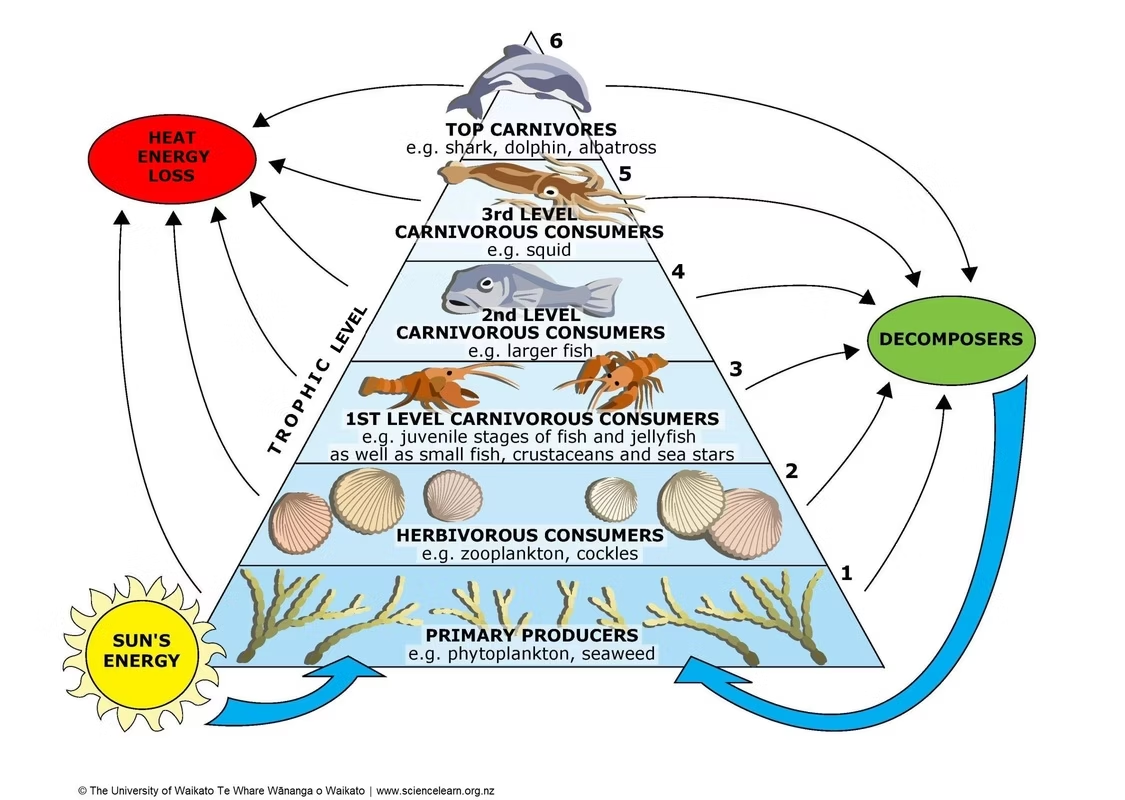
what is the energy pyramid? how does it work?
shows the flow of energy as it moves through the different trophic levels
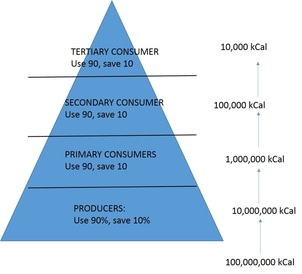
what is the biomass pyramid? what does it show and how does it work?
shows how the mass of living matter decreases as trophic levels get higher and higher, and the number of individuals in those levels decreases
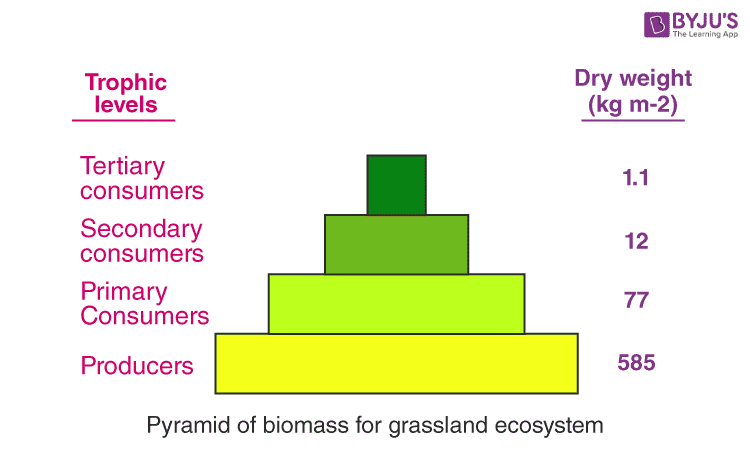
what is photosynthesis?
the process where an organism uses sunlight to make food (glucose). photosynthesis uses CO2, H2O, and light to produce glucose and O2.
how does photosynthesis work?
it’s carried out by autotrophs using chloroplasts. this occurs within autotrophs like plants algae, and some bacteria (producers, generally). inside of these organisms are chloroplasts, a structure inside of plant cells that carry out photosynthesis.
what are thylakoids?
these are flattened structures that hold photosynthetic pigments like chlorophyll, and they make cells look green (or just any color) by using light and wavelengths.
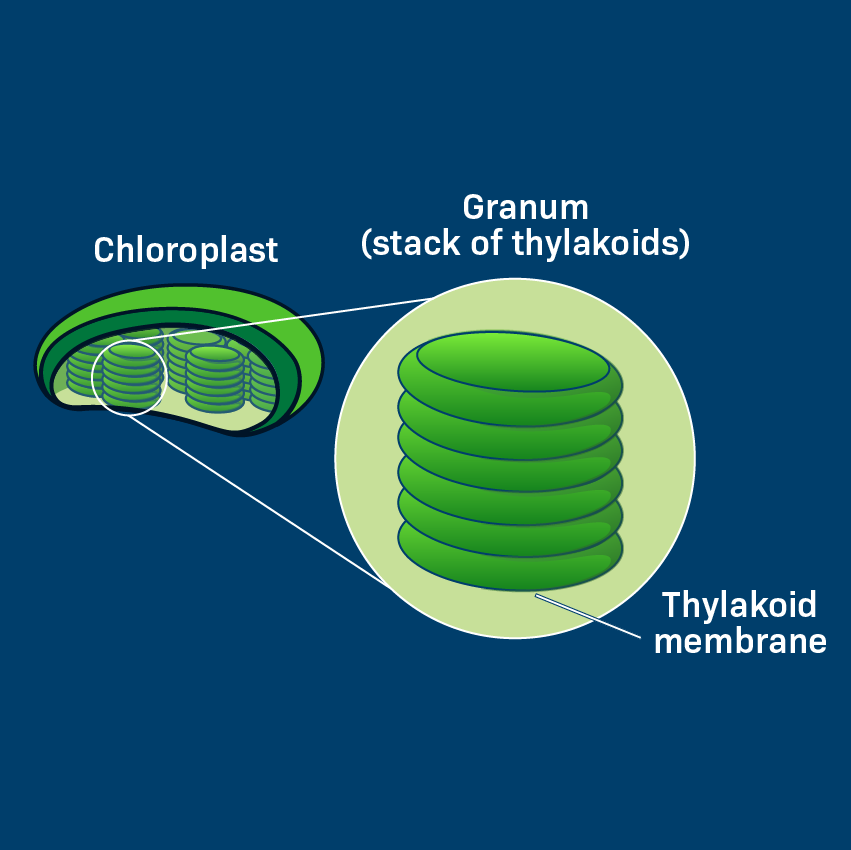
what is chlorophyll?
the pigmented molecules in thylakoids that absorb and reflect specific wavelengths of light.
how do chloroplasts work?
when light is absorbed, it provides energy for the photosynthetic process. when it is reflected, however, is bounces off of the cells and appear to the eye as color. chlorophyll, specifically, reflects mostly green light and absorbs other colors.
how does photosynthesis work (CO2 and O2)?
sunlight absorbed by photosynthetic pigments
carbon dioxide is brought in through plant leaves
water is absorbed through the plant roots
oxygen is let out through the plant leaves
glucose is made as ‘food’—> broken down for energy, stored (as starch) to be used for later
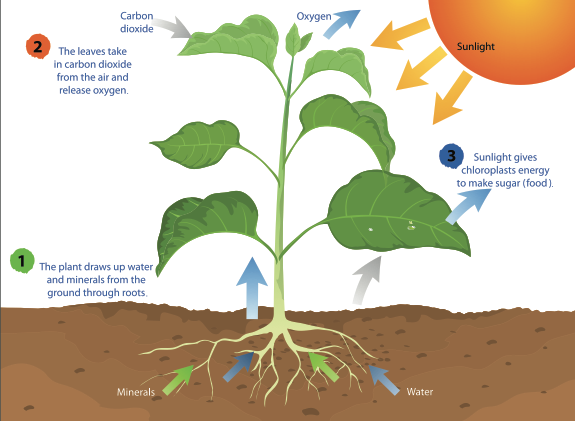
how does photosynthesis work (chloroplasts)?
thylakoids take in water and absorb light energy
light energy ‘charges up’ ADP into ATP and splits water into H2O to release oxygen
the chloroplast takes in CO2, enzymes use energy from ATP to convert CO2 and H from H2O into glucose
the ‘low energy’ ADP molecule is recycled back into the first part of the cycle
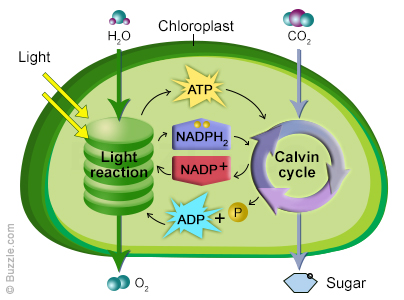
what are biochemical cycles?
they are nutrient cycles of earth’s life.
energy flows ‘one way,’ where it goes in as light energy, and out as heat (biotic factors only).
nutrients and matter get recycled, where changes form continuously (both biotic and abiotic factors).
how does the water cycle work?
main source: surface/ground water
enters through precipitation, exits through evaporation, plants absorb for photosynthesis
water is polar, meaning that it is a good solvent for breaking up molecules of living things
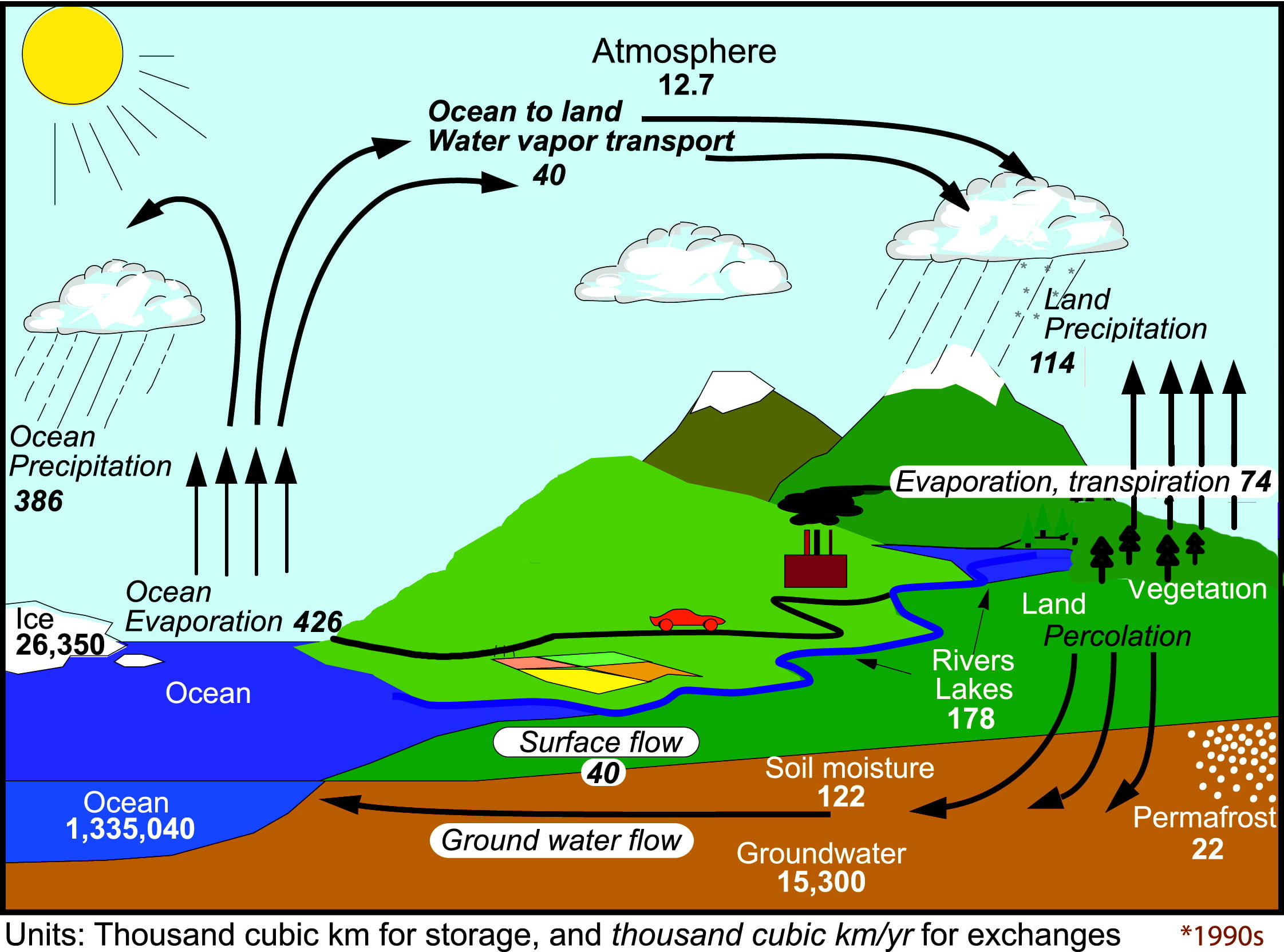
how does the carbon cycle work?
main source: inorganic CO2 in the atmosphere
enters through fossil fuel combustion and breathing, exits through photosynthesis
‘carbon is a building block of life’
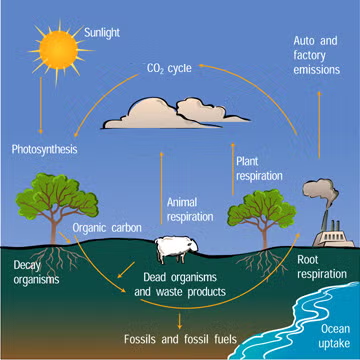
how does the nitrogen cycle work?
main source: N2 in the atmosphere
enters through gases from decomposition, exits as plants absorb N2 from the soil, grow, and animals eat those plants
nitrogen appears in all of our DNA
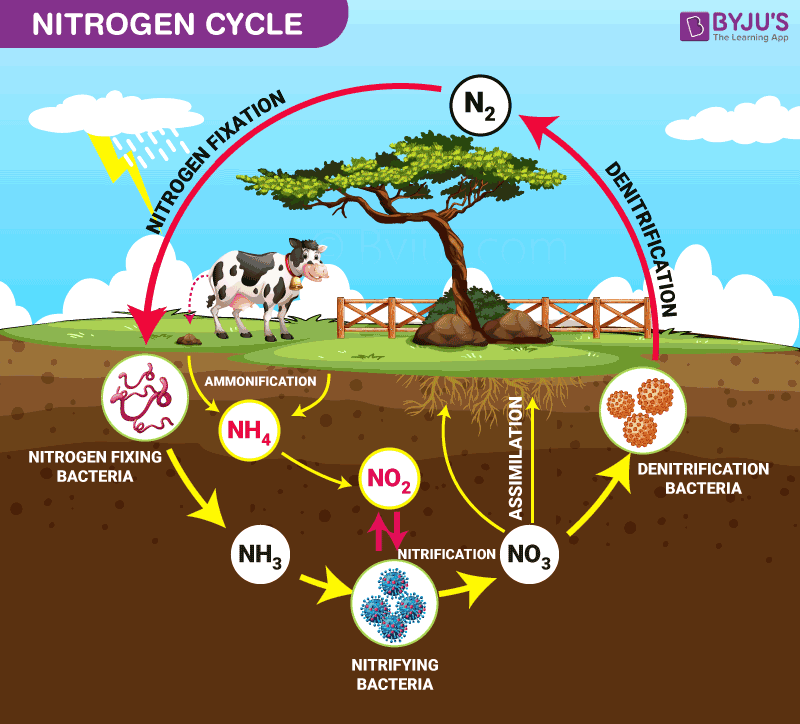
how does the phosphorous cycle work?
main source: rocks and soil
enters through decomposition of soil and becomes rocks, exists as rocks are broken down, phosphorus enters soil, then plants, and enters animals as they eat them
does not involve the atmosphere
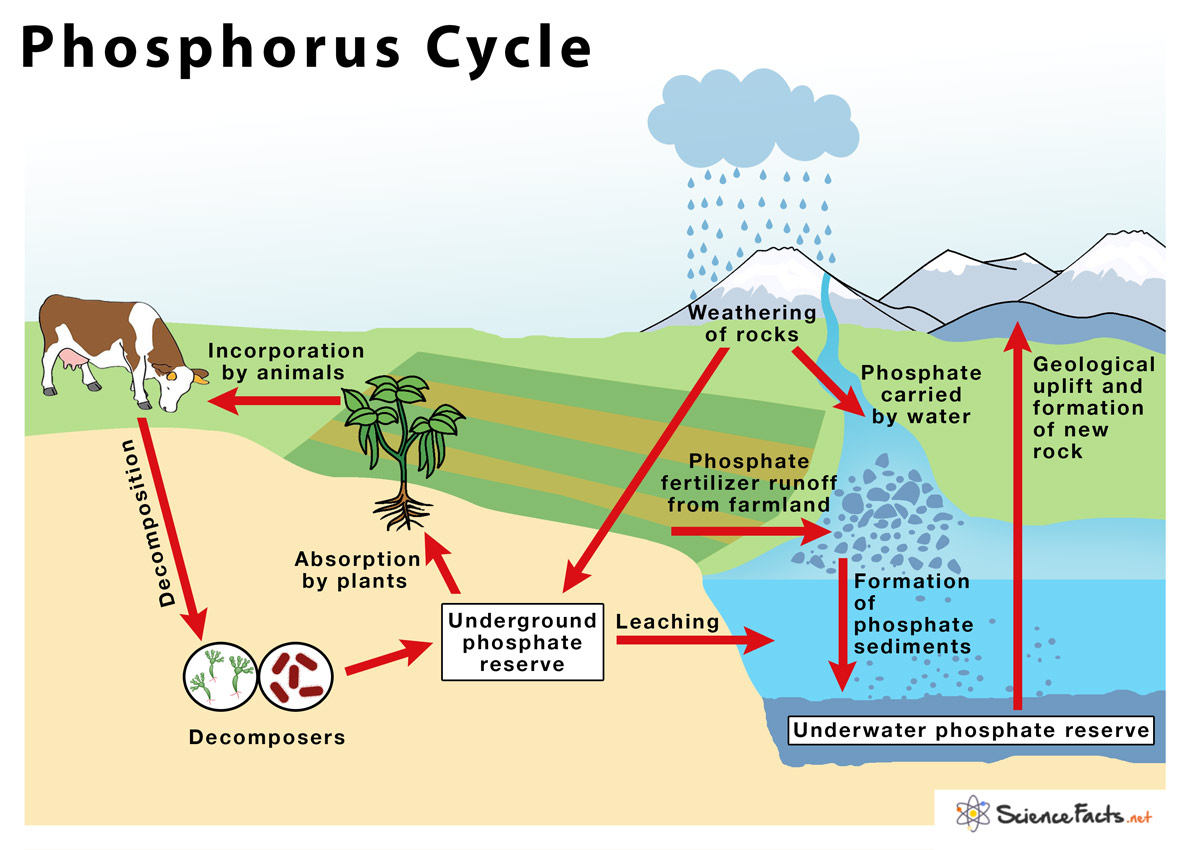
how does the sulfur cycle work?
main source: rocks and soil
enters through decomposition, which puts sulfur into the soil, which eventually will become rocks. exits when these rocks break down, reenter the soil, helping to grow plants, which animals eat
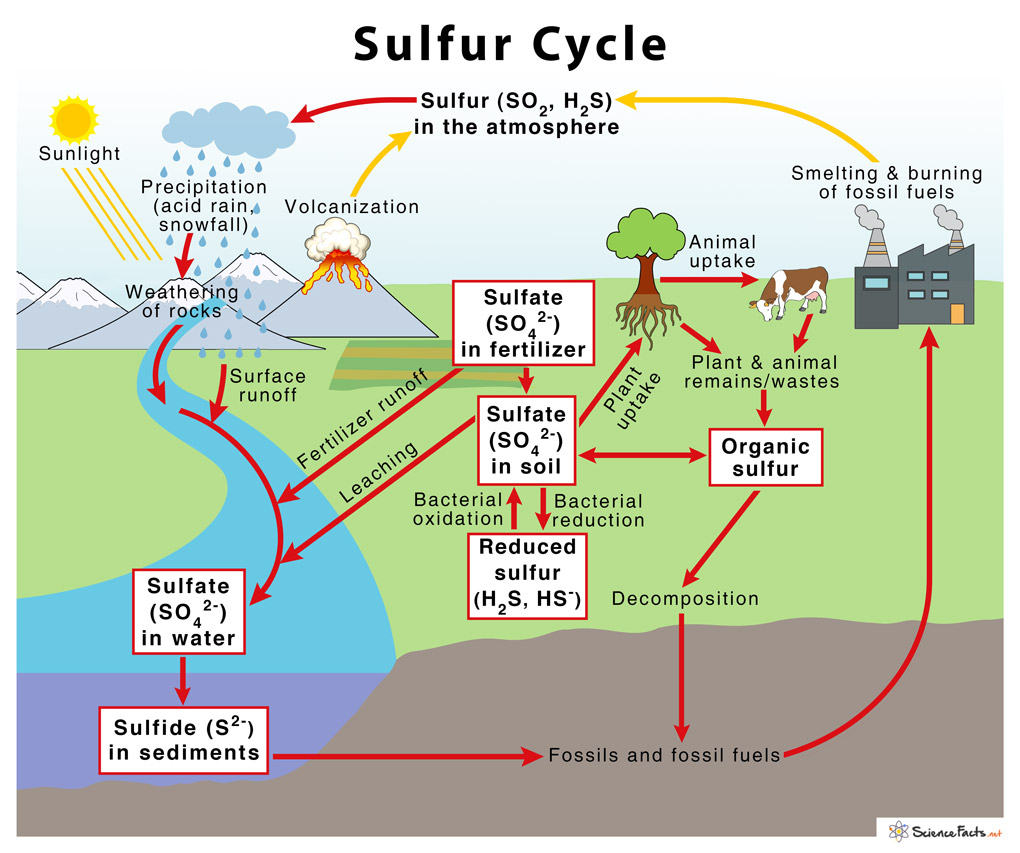
what is climate change?
the change in average climate over a long period of time. climate change refers to average regional patterns overtime, while weather refers to current outdoor conditions.
what causes climate change?
human activity, like burning fossil fuels, which releases greenhouse gases (like CO2 and methane)
greenhouse gases trap heat in earth’s atmosphere, which keeps the atmosphere at a necessary temperature for sustaining life, but too much of this can trap lots of heat
deforestation means that there are fewer trees/plants to absorb CO2 (via photosynthesis). this not only harms our atmosphere, but also affects food webs and habitats
what are some pieces of evidence for climate change?
rising global temperatures, where an increase in the amount of CO2 in the atmosphere correlates with the rising average temperature around the globe
in warming oceans, heat in the atmosphere is eventually absorbed by the water, altering habitats for marine life
what are some consequences of climate change?
increased temperature leads to melting snow/ice leads to rising sea levels, which damages habitats and disturbs life
burning fossil fuels releases CO2, which dissolves into water and creates carbonic acid. this harms organisms that have shells, dissolving their shells with the acid
a loss of biodiversity, which means less healthy ecosystems, largely due to extreme, rapid habitat changes